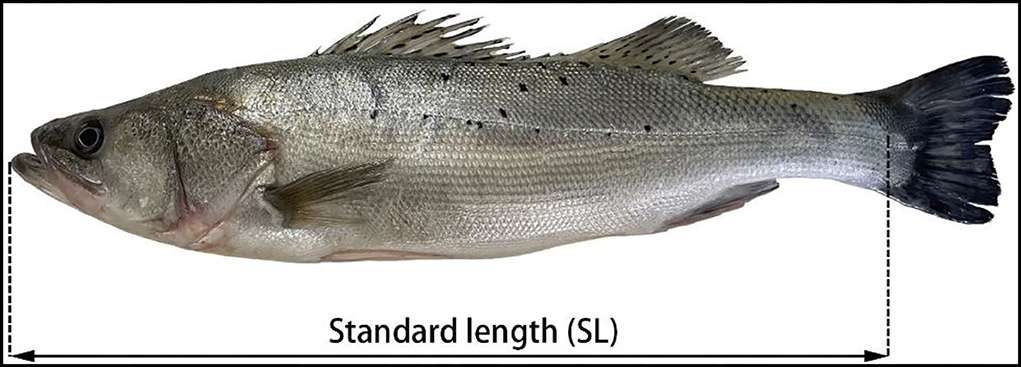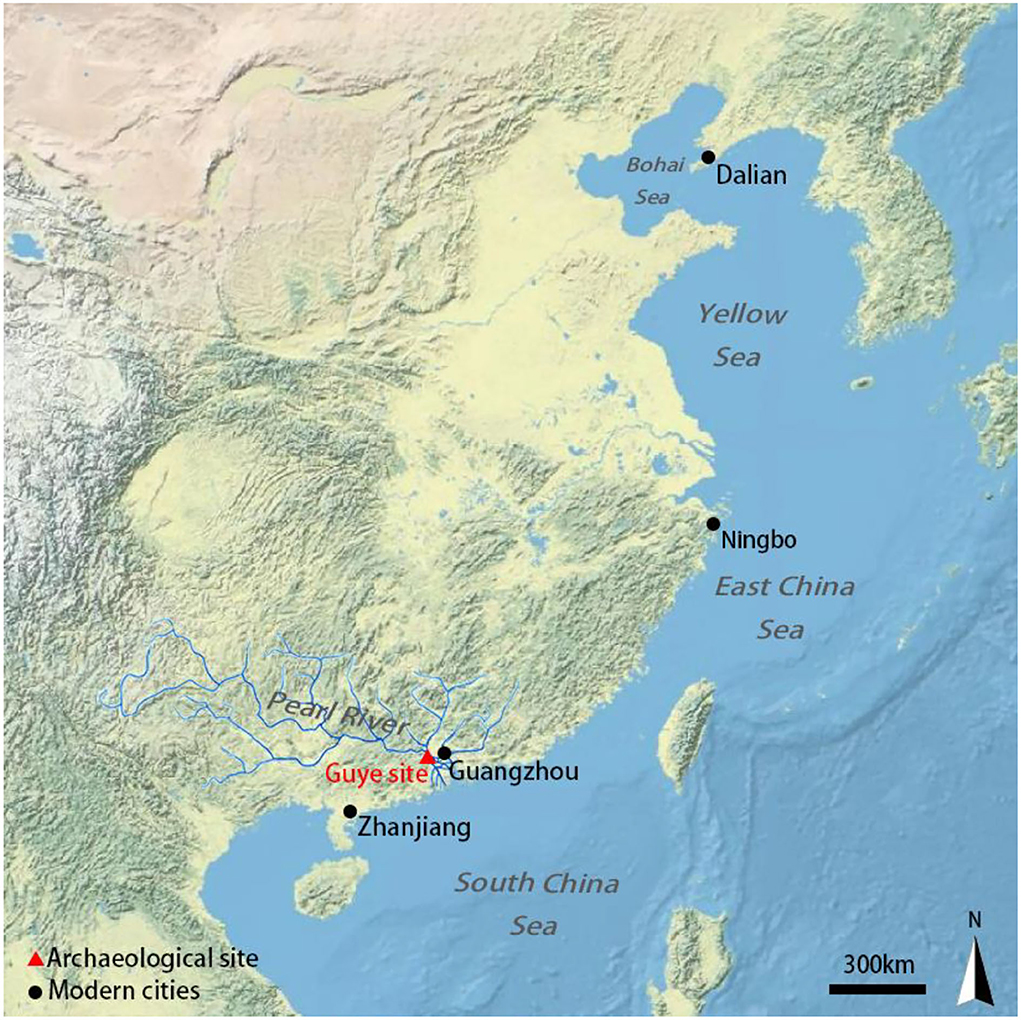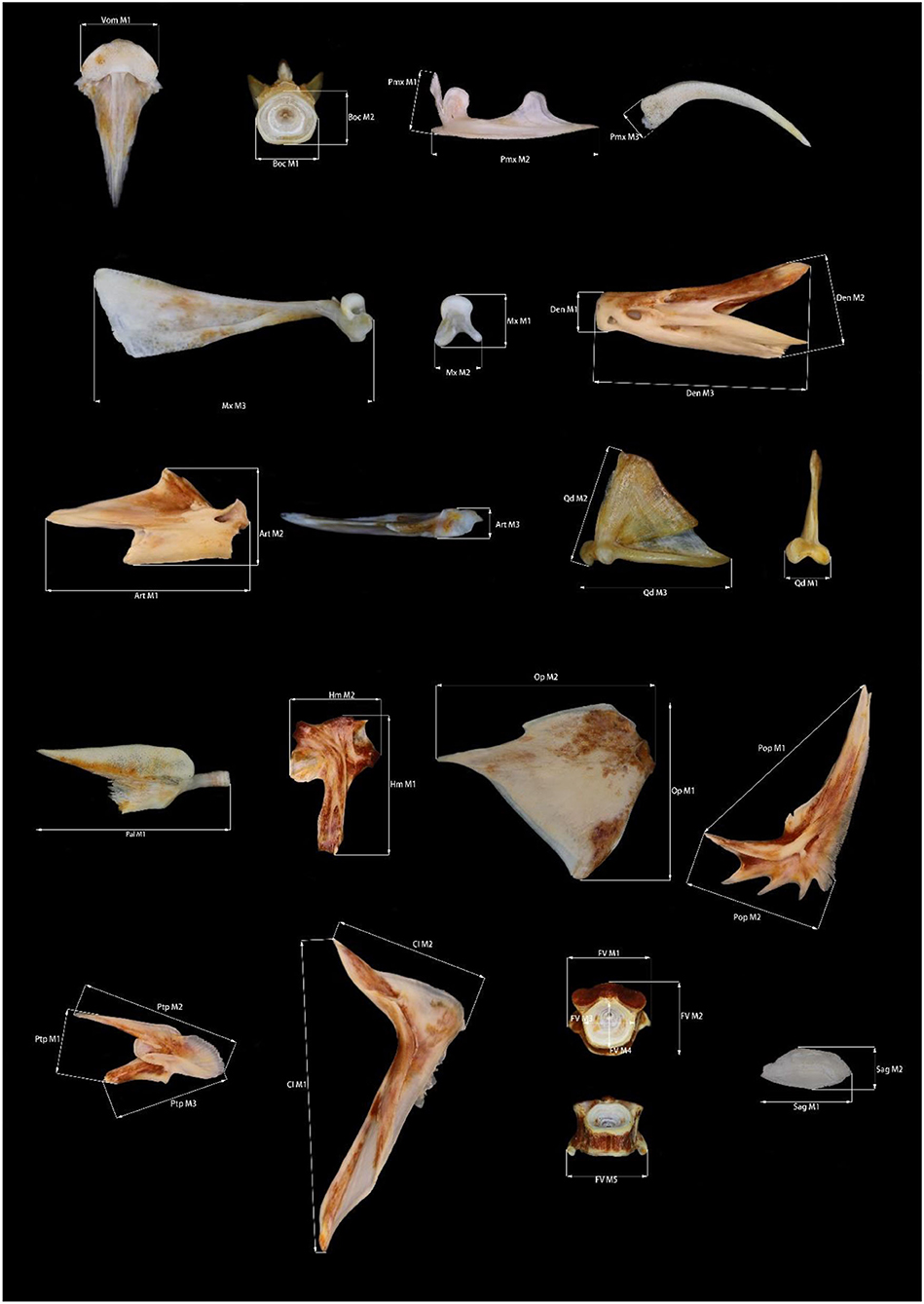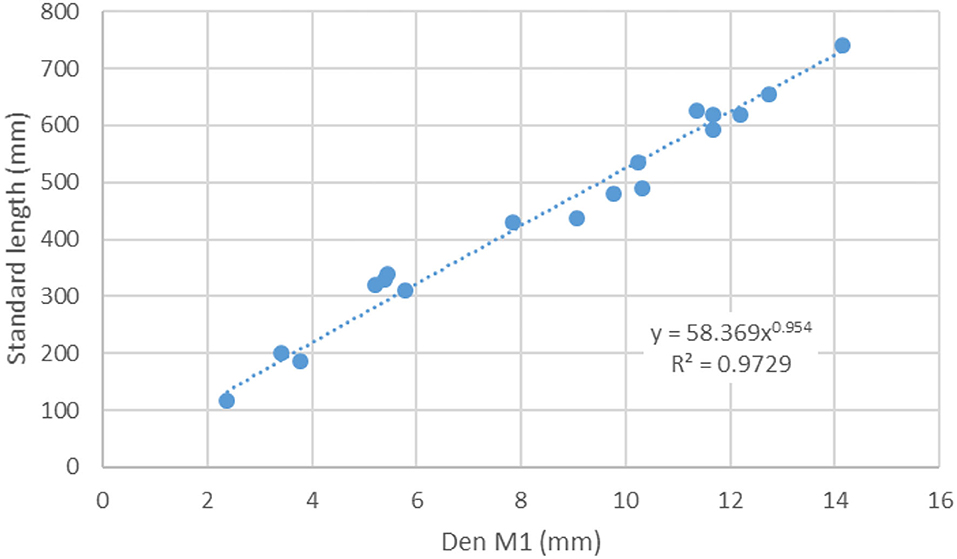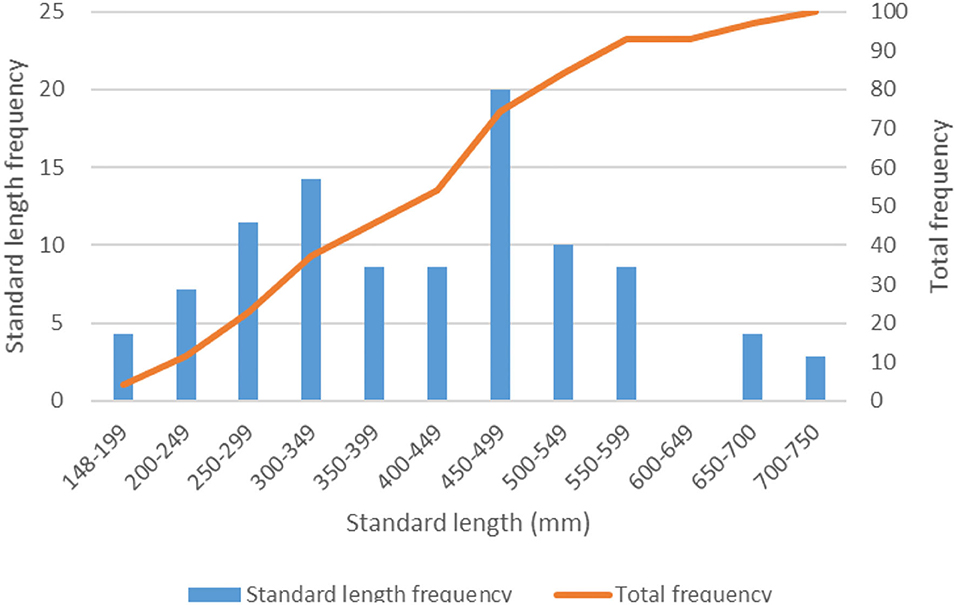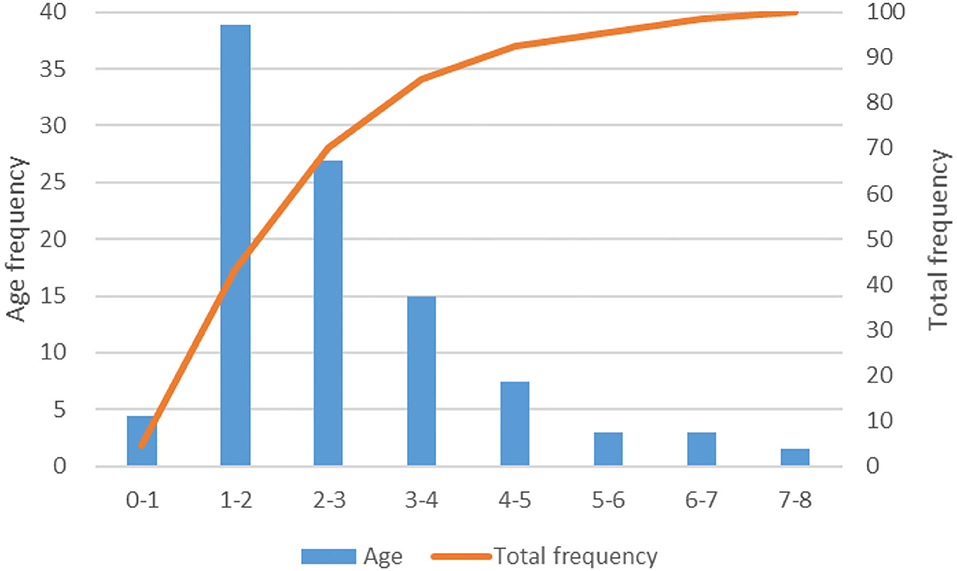- 1School of Sociology and Anthropology, Sun Yat-sen University, Guangzhou, China
- 2Guangdong Provincial Institute of Archaeology and Cultural Relics, Guangzhou, China
Fishing was an important form of subsistence economy among ancient societies. However, details of past fishing activities have been rarely studied in China. This paper uses data extracted from a modern fish collection to estimate the body size and age of Chinese sea bass from the Guye site, a common species that is frequently discovered in archaeological sites of coastal South China. The distribution of body size and age were reconstructed and combined with fish biology and ecology; the current dataset revealed that the main fishing grounds of the Late Neolithic Guye people were close to the shoreline, and the main fishing season was from spring to early autumn.
Introduction
The reconstruction of fish body size is an important indicator that not only provides crucial information about the size range and distribution of fish size in an ichthyoarchaeological assemblage, but allows further interpretation of past fishing methods, grounds, gears, and seasons (Wheeler and Jones, 1989). Previous ichthyofaunal studies in China focused on the freshwater taxa from the Tianluoshan and Jiahu sites in the Lower Yangtze River region (Nakajima et al., 2011, 2012, 2015, 2019; Matsui et al., 2016; Zhang, 2018; Maruyama et al., 2021). The regression formulas for common carp (Cyprinus carpio) and snake head (Channa argus) were calculated aiming to look for early aquaculture and rice paddy field management (Zhang, 2018; Nakajima et al., 2019).
However, given that the varied fish species from the Pearl River Delta region of South China are very different from those of the Lower Yangtze River region, it is necessary to select some species of fish to initially develop the use of osteometric measurements as a means of estimating fish body size. This study provides regression formulas for size estimation of Chinese sea bass (Lateolabrax maculatus), the most abundant marine species in the Guye site and is also commonly recovered from archaeological sites bordering coastal South China (Yu and Cui, 2021). The present study reveals the patterns of the body size and age of Chinese sea bass that are linked with fishing strategies in coastal South China during the Late Neolithic age, which helps to elucidate the mechanisms of the sustainability and complexity of fishing-hunting-gathering communities in antiquity.
Ichthyological biology and ecology
There has been disagreement on the ichthyological taxonomy of Lateolabrax (Teleostei: Perciformes: Lateolabracidae: Lateolabrax). FishBase (Froese and Pauly, 2022) and the latest version of Fishes of the World (Nelson et al., 2016) suggest there are only two species in genus Lateolabrax, namely L. japonicus (Japanese sea bass) and L. latus (black fin sea bass). However, local ichthyologists argued that L. maculatus (Chinese sea bass) and L. japonicus are different species based on modern morphology, genetics, ecological habits, and natural distributions (Yokogawa, 1993, 2004, 2019; Yokogawa and Seki, 1995). The Chinese sea bass is characterized by its lifelong black spots on body and dorsal fins although some might gradually downsize with growth, generally they are still larger than the scales (Figure 1). It is broadly distributed along the entire Chinese coast's offshore waters including the Bohai Sea, Yellow Sea, East China Sea, South China Sea, and west coast of the Korean Peninsula (Figure 2) (Feng and Jiang, 1998). Black spots on Japanese sea bass are usually scattered above lateral line on the juvenile individuals and then vanish at 21–25 cm standard length, the spots are about the size of, or smaller than, the scales. This fish is commonly found in the east coast of the Korean Peninsula and Sea of Japan (Yokogawa and Seki, 1995; Yokogawa, 2004). Black fin sea bass have no black spots and are distributed along the entire Japanese coast's offshore waters including the west coast of the Sea of Japan, and the west shores of the Honshu, Shikoku, and Kyushu islands (Katayama, 1957; Overseas fishery cooperation foundation of Japan, 2009; Wu and Zhong, 2021). Although we are unable to distinguish the bone characteristics among them due to the lack of comparative material, the main fisheries in prehistoric coastal South China can be identified as L. maculatus according to their modern distribution.
Chinese sea bass is a euryhaline teleost which can live in salinities ranging from freshwater to seawater environments. Some juveniles can survive in freshwater where they grow into adults before migrating back into the ocean to spawn. Chinese sea bass are frequently found in the moving water of rocky reefs when they are inshore. They migrate seasonally, leaving the coast during winter to stay in wintering grounds and spawn, usually in an offshore area; and enter shallow waters near the coast or inside the bay in spring and summer for feeding. The older the fish is, the further they migrate (Feng and Jiang, 1998).
Materials and methods
Modern fish collection
A total of 20 Chinese sea bass were collected at fish markets of coastal China, including Dalian (Liaoning province), Ningbo (Zhejiang province), Guangzhou, and Zhanjiang (Guangdong province) (Figure 2). Body measurements were conducted, including standard length (SL) in millimeters, and the total fresh weight (W) in grams (Figure 1). The Chinese sea bass involved in this study ranged from 116 to 740 mm and from 23 to 5675 g (Table 1). According to Feng and Jiang (1998), this species can reach 817 mm in standard length, which indicates that our collection covered almost the full range of size that this species can attain, although the number of individuals is not as great as many similar studies (Yeomans, 2016; Lidour et al., 2018; Martínez-Polanco and Béarez, 2020; Rurua et al., 2020; Martínez-Polanco et al., 2022).
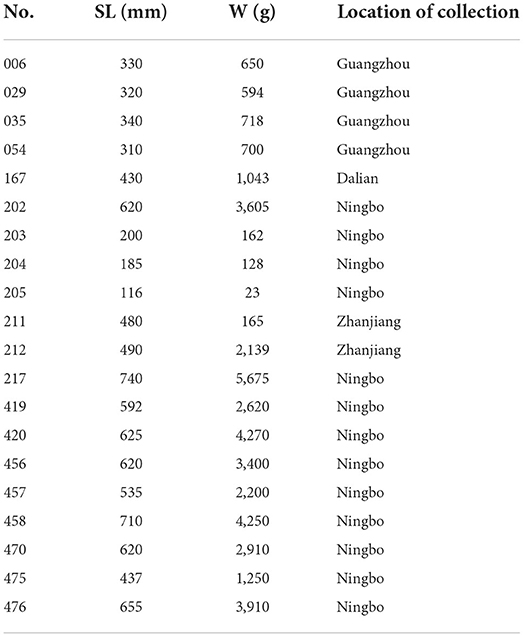
Table 1. Standard length, weight, and location of collection of Chinese sea bass (Lateolabrax maculatus) used in this study.
Osteological nomenclature of bones mainly follows Lepiksaar (1994) and Dye and Longenecker (2004). Bone measurements are described in Table 2 and illustrated in Figure 3. All biometric data were taken using a Mitutoyo caliper (precision: tenths of a millimeter) with a precision of two decimal points. The same dimensions of the right and left sides are averaged.
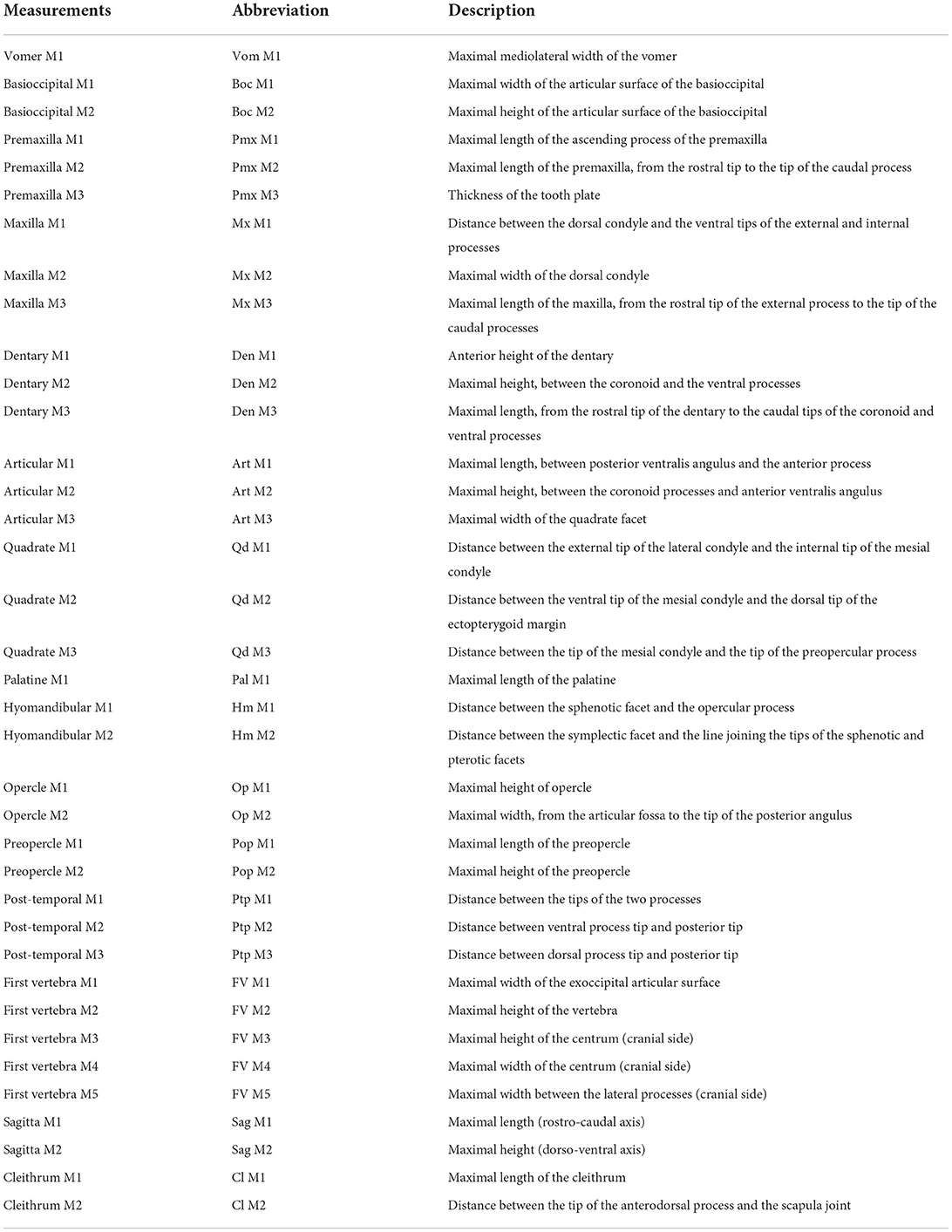
Table 2. Descriptions of the bone measurements taken from Chinese sea bass (Lateolabrax maculatus) skeletons.
Archaeological samples
The site of Guye (Late Neolithic period, 5,900–5,400 cal. BP) is situated on the west bank of the Pearl River Delta, and was proved to be the earliest shell midden site of the region (Cui, 2007). All the excavated sediments were systematically wet sieved using different sizes of meshes (1.5 and 4 mm). This sampling method provided enormous amounts of faunal remains. Preliminary zooarchaeological investigations have revealed that the subsistence economy of Guye heavily relied on fishing. Among the whole assemblage, 11,407 fish bones were sorted with a total of 2,452 remains identified to family level or below (i.e., genus, species), making it the first ichthyofaunal dataset from prehistoric populations in coastal South China. Chinese sea bass was the most common marine species, it comprised about 22% of the total NISP and MNI (Yu and Cui, 2021).
The calculation of regression formulas
The calculation of regression formulas for Chinese sea bass was based on a set of modern fish collected with known length and weight (Table 1). Clear dimensions shown on Figure 3 were used to generate length-length and length-weight equations represented by Y = aXb whereas Y is the standard length and weight of the fish, respectively, X is the measurement of the representative dimension from the modern collection. The quality of the relationship is given by the coefficient of determination (R2) which ranges from 0 to 1. The value of R2 shows whether the model would be a good fit for the given data set. Generally, a higher coefficient indicates a better fit for the model. With good coefficient of determination, the functions can be used to estimate the length and the weight of the fish from its isolated bones.
Result
Length-weight equation
A standard length-weight model was obtained in the form W = aSLb, with the W in grams and the SL in millimeters. The standard length-weight relationships reflected a slight allometric growth (b = 2.815), with a high coefficient of determination (R2 = 0.9879) (Figure 4).
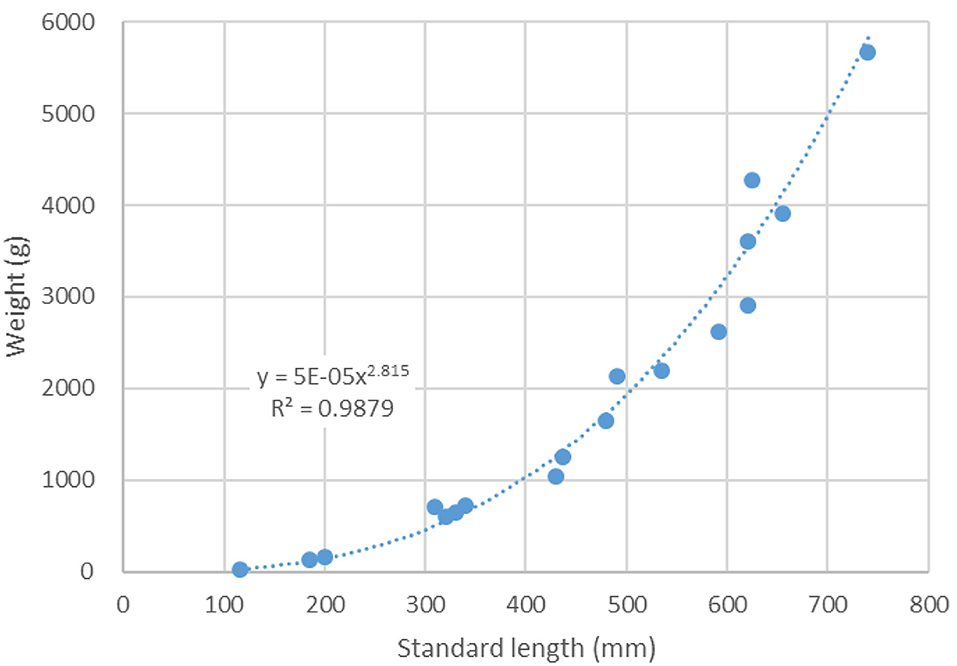
Figure 4. Standard length (SL) to weight (W) relationship of the modern sample of Lateolabrax maculatus.
Bones measurements and regression analysis
Equations are given in the form SLfish = aM, where all the measurements are taken and calculated in millimeters. The a and b parameters and R2 are provided in Table 3. All of the equations show a good coefficient of determination; the maximal R2 is 0.9925, the minimal R2 is 0.9591, with an average of 0.9803. The correlations of the preopercle measurements (R = 0.9909; R = 0.9887; R = 0.9898) are very good. Followed by hyomandibular (R = 0.9888; R = 0.9904; R = 0.9896). The measurements of maxilla provide the lowest coefficients, still superior to 0.967, however.
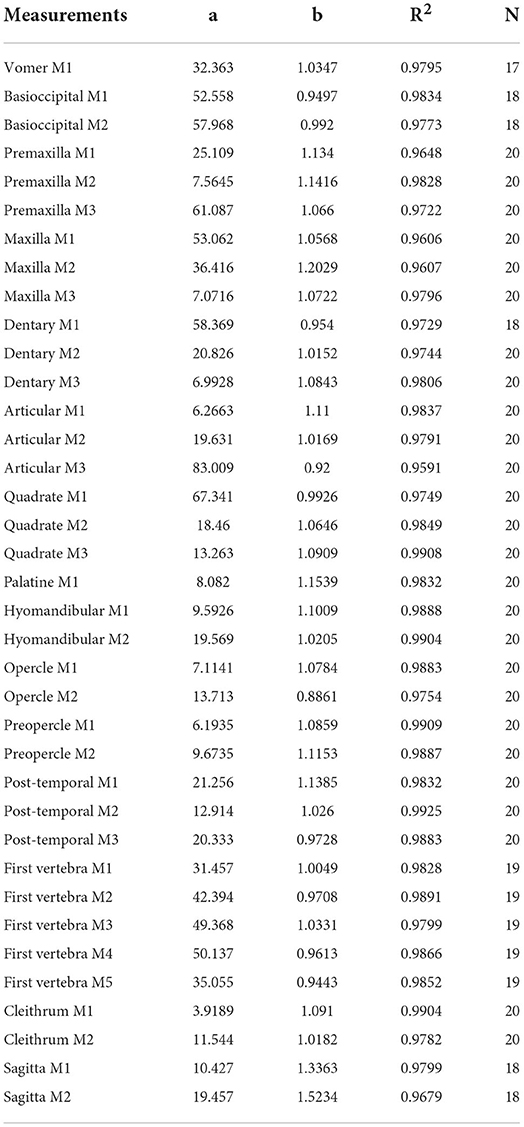
Table 3. Regression formula parameters for estimating the total length of Chinese sea bass (Lateolabrax maculatus) from bone measurements (in mm).
Ichthyoarchaeological application
The ichthyoarchaeological application of regression formulas needs a set of measurements from frequent and well-preserved bones in the archaeological assemblages. According to the distribution of fish skeletal parts from the Guye site, the most frequently recovered element of Chinese sea bass is the opercle (Table 4), which is diagnostic with its thickness and pointedness at the posterior end. However, the opercle is very porous as seen from the cross section, which might be the cause of high fragmentation of this element, and therefore it lacks measurable dimension. The anterior of the dentary is very robust and the three oval openings on the outer surface make it easy to identify (Yu, 2022). Thus, the anterior height of the dentary (Den M1) was selected for the reconstruction of body length, due to its high correlation coefficient and frequency (R2 = 0.9729) of corresponding bones in the archaeological contexts (Figure 5).
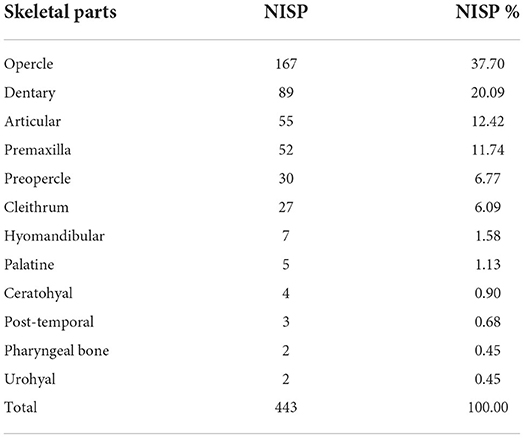
Table 4. Distribution of Chinese sea bass skeletal parts at the Guye site (in descending order of NISP).
In total, 70 measurements of Den M1 were collected from the Guye assemblage, the minimal reconstructed length was 148.47 mm (SL) and the maximum was 728.7 mm (SL), which gave a mean of 417.79 mm (SL) and a median of 433.18 mm (SL). The main size class represented was 250–550 mm (N = 51; 72.86% of the total population) (Figure 6).
Discussion and interpretation
Length–age relation
Growth in fish is indeterminate, which means growth continues throughout the life span of an individual, although at a constantly decelerating rate. Hence older animals are generally larger (Helfman et al., 2009). To estimate the age of Chinese sea bass, we used data collected from 528 individuals from the north Yellow Sea and Bohai Sea by Feng and Jiang (1998) to generate an age-length equation (Figure 7). We then applied estimated body length by dentary anterior height to calculate age for each individual.
It is obvious that the proportion of individuals caught at an age < 1 year-old is quite small (4.48%), while 65.67 % of the sea bass were caught between 1 and 3 years of age, 14.93% of the corpus were consumed around 3–4 years-old and same proportion for individuals older than 4 years of age (Figure 8). As Chinese sea bass were sexually mature around 3 years old (Feng and Jiang, 1998), this means that < 30% of the catches were mature individuals.
Seasonality evidence and fishing strategies
In the fish assemblages of the Guye site, Chinese sea bass and mullet were the most common marine species. About 17% of the total NISP and MNI belong to Mugilidae, represented by opercle, dentary, lachrymal, and vertebrae. However, it is difficult to differentiate them to the genus level due to similar morphological appearances, especially in archaeological contexts. Based on their body size in modern fishery records, we assumed that mullets in the corpus probably belong to Liza haematocheilus (redlip mullet) or Mugil cephalus (striped mullet) (Yu and Cui, 2021).
Redlip mullet inhabit shallow coastal waters; they can also enter freshwater regions of rivers. They migrate offshore in the winter and move back inshore in spring for feeding and spawning. Striped mullet are frequently found coastally in estuaries and freshwater environments and inhabit sandy or muddy bottoms. Adults form huge schools and migrate offshore in large aggregations during fall and spawn during winter. Parent fish and larvae migrate back inshore to the feeding ground in spring and summer times. Striped mullet move into deeper waters as they grow (Zhao et al., 2016). Because we are unable to identify those mullets to genus or species, it is not possible to reconstruct their body size. However, their migratory patterns are almost the same as Chinese sea bass, that is, offshore during winter and inshore during spring and summer.
Fishing methods in nearshore and offshore water areas are different in the modern marine fishery. Mid-water or bottom trawl and purse net are commonly used in offshore water together with advanced fishing boats, particularly during winter (Yang, 2007). In the Guye site, Chinese sea bass and mullet comprised about two-thirds of the total marine species (both NISP and MNI) (Yu and Cui, 2021). If we assume that large-scale fishing activities in offshore water during winter in the Late Neolithic period is rare, then most of the marine fish were caught when winter migration ended, during spring, summer, and early autumn in nearshore and bay areas.
Conclusion
This study, for the first time, provides regression formulas for size estimation of fish species from the coastal South China area. Measurements taken on bones of modern Chinese sea bass enable us to reconstruct the body size of fish discovered in archaeological sites. Based on the length-age equation, the majority of Chinese sea bass collected from the Guye site ranged from 250 to 550 mm and aged from 1 to 3 years old. Based on fish biology and ecology, the cluster of these individuals indicates a fishing ground close to the shoreline. In conjunction with evidence on the characteristics of migration patterns from mullet, the main fishing seasons could be ranged from spring to early autumn.
Data availability statement
The original contributions presented in the study are included in the article/supplementary material, further inquiries can be directed to the corresponding author.
Ethics statement
Ethical review and approval were not required for the study of animals in accordance with the local legislation and institutional requirements.
Author contributions
CY: conceptualization, methodology, formal analysis, data curation, funding acquisition, writing—original draft, writing—review, and editing. YC: resources and fieldwork administration. All authors contributed to the article and approved the submitted version.
Funding
This study was supported by the National Social Science Fund of China (Grant No. 18CKG005).
Acknowledgments
We would like to thank Zixian Jiang for her contribution to photo editing. We are also grateful to the reviewers who helped us improve the final version of this paper.
Conflict of interest
The authors declare that the research was conducted in the absence of any commercial or financial relationships that could be construed as a potential conflict of interest.
Publisher's note
All claims expressed in this article are solely those of the authors and do not necessarily represent those of their affiliated organizations, or those of the publisher, the editors and the reviewers. Any product that may be evaluated in this article, or claim that may be made by its manufacturer, is not guaranteed or endorsed by the publisher.
References
Cui, Y. (2007). Discoveries of Guye Shell Midden Site in Guangdong Province, Gaoming County. Weekly of China's Cultural Relics Jan 12th
Dye, T. S., and Longenecker, K. R. (2004). Manual of Hawaiian fish remains identification based on the skeletal reference collection of Alan C. Ziegler and Including Otoliths. Honolulu: Society for Hawaiian Archaeology.
Froese, R., and Pauly, D. (2022). FishBase. World Wide Web electronic publication. Available online at: www.fishbase.org (accessed October 8, 2022).
Helfman, G., Collette, B., Facey, D., and Bowen, B. (2009). The Diversity of Fishes. Chichester: Wiley-Blackwell.
Lidour, K., Vorenger, J., and Béarez, P. (2018). Size and weight estimations of the spangled emperor (Teleostei: Lethrinidae: Lethrinus nebulosus) from bone measurements elucidate the fishing grounds exploited and ancient seasonality at Akab (United Arab Emirates). Int J. Osteoarchaeol. 28, 681–694. doi: 10.1002/oa.2683
Martínez-Polanco, M. F., and Béarez, P. (2020). An osteometric approach to reconstruct the length and weight of Lutjanus argentiventris (Perciformes: Lujtanidae) for archaeological and ecological purposes. Neotropical Ichthyol. 18, 1–16. doi: 10.1590/1982-0224-2019-0106
Martínez-Polanco, M. F., Béarez, P., Jiménez-Acosta, M., and Cooke, R. G. (2022). Allometry of Mexican hogfish (Bodianus diplotaenia) for predicting the body length of individuals from two pre-Columbian sites in the Pearl Island archipelago (Panama). Int J. Osteoarchaeol. 32, 669–681. doi: 10.1002/oa.3094
Maruyama, M., Kikuchi, H., Sun, G., Yu, C., and Zhang, Y. (2021). Fish utilization during the Neolithic in the lower Yangtze river, China: a case study of Tianluoshan site. Zooarchaeology 38, 1–9.
Matsui, A., Shinkai, R., Maruyama, M., and Sun, G. (2016). “Fish remains from the Tianluoshan site,” in: The Origin and Diffusion of Livestock and Poultry in Neolithic East Asia: New Zooarchaeological Evidence from China, eds A. Matsui and H. Kikuchi (Nara: Meishinsha). p. 7–14.
Nakajima, T., Hudson, M. J., Uchiyama, J., Makibayashi, K., and Zhang, J. (2019). Common carp aquaculture in Neolithic China dates back 8,000 years. Nat Ecol Evol 3, 1415–1418. doi: 10.1038/s41559-019-0974-3
Nakajima, T., Lv, P., Zhang, J., Nakajima, M., Makibayashi, K., and Yuan, J. (2015). Cyprinid pharyngeal bone and tooth remains from the Neolithic Jiahu site, Wuyang County, Henan Province, China. Quaternary Sci. 35, 192–198.
Nakajima, T., Nakajima, M., Mizuno, T., Sun, G., He, S., and Liu, H. (2012). On the pharyngeal tooth remains of crucian and common carp from the Neolithic Tianluoshan site, Zhejiang Province, China, with remarks on the relationship between freshwater fishing and rice cultivation in the Neolithic Age. Int. J. Osteoarchaeol. 22, 294–304. doi: 10.1002/oa.1206
Nakajima, T., Nakajima, M., Sun, G., and Nakamura, S. (2011). “Pharyngeal tooth remains from the fish bone pit (K3) at Tianluoshan,” in Integrated Studies on the Natural Remains from Tianluoshan. Centre for the Study of Chinese Archaeology in Peking University, and Zhejiang Province Institute of Archaeology and Cultural Heritage (Beijing: Cultural Relics Press). p. 206–236.
Nelson, J. S., Grande, T. C., and Wilson, M. V. H. (2016). Fishes of the World. Hoboken: John Wiley and Sons, Inc. doi: 10.1002/9781119174844
Overseas fishery cooperation foundation of Japan (2009). Names and Illustrations of Fishes from the East China Sea and the Yellow Sea. Nagasaki: Nihon Shiko Printing Co., LTD.
Rurua, V. A., Béarez, P., Hermann, A., and Conte, E. (2020). Length and weight reconstruction of Chlorurus microrhinos (Scaridae) from isolated cranial bones and vertebrae. Cybium 44, 61–68. doi: 10.26028/cybium/2020-441-008
Wu, H., and Zhong, J. (2021). Key to Marine and Estuarial Fishes of China. Beijing: China Agriculture Press.
Yang, L. (2007). Fishing Gears and Fishing Methods in South China Sea. Guangzhou: Guangdong Science and Technology Press.
Yeomans, L. (2016). Size estimation of kingsoldier bream (Argyrops spinifer) and evidence of fishing strategies. Int. J. Osteoarchaeol. 26, 799–807. doi: 10.1002/oa.2481
Yokogawa, K. (1993). Nomenclatural reassessment of the sea bass Lateolabrax maculatus (McClelland, 1844) (Percichthyidae) and a redescription of the species. Biogeography 15, 21–32.
Yokogawa, K. (2004). Biological characteristics and specific divergence of fishes in genus Lateolabrax (Perciformes: Percichthyidae) (Dissertation). Ehime University.
Yokogawa, K. (2019). Morphological differences between species of the sea bass genus Lateolabrax (Teleostei, Perciformes), with particular emphasis on growth-related changes. ZooKeys 859, 69–115. doi: 10.3897/zookeys.859.32624
Yokogawa, K., and Seki, S. (1995). Morphological and genetic differences between Japanese and Chinese sea bass of the genus Lateolabrax. Jpn. J. Ichthyol. 41, 437–445.
Yu, C. (2022). Identification of skeletons of Lateolabrax maculatus and Lates calcarifer from archaeological sites. Cult. Relicsin Southern China 2, 155–161.
Yu, C., and Cui, Y. (2021). Fishing-reliant subsistence system among prehistoric coastal communities in South China: an ichthyoarchaeological case study on the Guye site. Archaeol. Anthropol. Sci. 13, 129. doi: 10.1007/s12520-021-01381-6
Zhang, Y. (2018). “Exploring the wetland: Integrating the fish and plant remains into a case study from Tianluoshan, a Middle Neolithic site in China,” in Environmental Archaeology, eds E. Pişkin, A. Marciniak, and M. Bartkowiak (Cham: Springer). p. 199–227. doi: 10.1007/978-3-319-75082-8_10
Keywords: body size estimation, age estimation, Chinese sea bass, Guye site, ichthyoarchaeology
Citation: Yu C and Cui Y (2022) Body size and age estimation of Chinese sea bass (Lateolabrax maculatus) and evidence of Late Neolithic fishing strategies, a case study from the Guye site. Front. Ecol. Evol. 10:1018615. doi: 10.3389/fevo.2022.1018615
Received: 13 August 2022; Accepted: 10 October 2022;
Published: 08 November 2022.
Edited by:
Ren Lele, Lanzhou University, ChinaReviewed by:
Lisa Yeomans, University of Copenhagen, DenmarkMasashi Maruyama, Tokai University, Japan
Copyright © 2022 Yu and Cui. This is an open-access article distributed under the terms of the Creative Commons Attribution License (CC BY). The use, distribution or reproduction in other forums is permitted, provided the original author(s) and the copyright owner(s) are credited and that the original publication in this journal is cited, in accordance with accepted academic practice. No use, distribution or reproduction is permitted which does not comply with these terms.
*Correspondence: Chong Yu, eXVjaG9uZzNAbWFpbC5zeXN1LmVkdS5jbg==
 Chong Yu
Chong Yu Yong Cui2
Yong Cui2